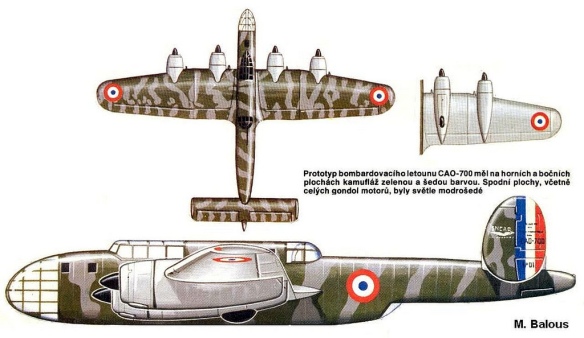Only one aircraft was built, and his maid flight had to be on June 25th 1940. But this day was the day of the Armistice. The aircraft was to take off but the order was given to stop the engines.
SNCAO was a short-lived company originating from the nationalization of Loire-Nieuport and Breguet factories. It had design studies in Issy-les-Moulineaux (former Nieuport), using even numbers (200, 400…), and in Saint-Nazaire (former Loire), using odd numbers.
– CAO.200 fighter, 1 built
– CAO.30, ex LN.30 pusher flying-boat, 2 built
– CAO.300, series version of CAO.30, none built
– CAO.400 observation (T3), two Lorraine Algol, not finished
– CAO.500 seaplane fighter project
– CAO.600 carrier-borne torpedo and dive bomber, two 14M engines, 1 built
– CAO.700 four-engine bomber, 1 built
– CAO.720 four-engine transport aircraft project
– CAO.810 single-engined dive bomber project
– CAO.900 two-engine high-wing amphibian
– CAO.1000 carrier-borne fighter project
A program of measures to enhance the quality and quantity of the French Air Force, adopted by the Ministry of Aviation of France in 1936-1938. In the last prewar years on arms had to take many different aircraft types and categories, but among them there was no heavy long-range bomber. This is explained by the fact that for some time the headquarters of the Air Force did not take into account the importance of strategic bombing, which was a consequence of subordination or the entire aviation army or navy. Since 1923, when the Air Force became a separate combat arm, position on this issue is also not much improved. Then all addicted to the multi-purpose aircraft and heavy bombers, it somehow never came. Only when from abroad began to receive threatening news about the appearance of these machines have a probable enemy, the French began to take steps to address this problem.
In early 1938, the Air Ministry specification A.20 formulated requirements for heavy long-range bomber category B5, which was to operate during daylight hours. Among other characteristics indicate speeds of at least 450 km\h, range 7,000 km, bomb load of approximately 3,000 kg and cannons. The competition was attended by four firms, will soon submit a draft aircraft Bloch MB.162, Amiot 380, Breguet Br.482 and SNCAO CAO.700. Favorite in this competition was MV.162 since it was created on the basis of long-range passenger aircraft MV.161 and had a good chance to be launched into production in the near future, however, the preliminary draft SAO.700 under consideration in July 1937.
Long-range bomber SAO.700V5 had normal-metal structure with retractable landing gear in flight and four radial engines Gnome-Rhone 14N-49 wing. The front part of the fuselage had a large glass area and provide the best possible coverage. The cabin located pilot and navigator, and in the central part of equipped space for airborne shooters, one of which served 7.5-mm machine gun (at the bottom), while the top weapon was 20-mm cannon HS-404. Wing received a high degree of mechanization with slats and Fowler flaps.
The first prototype SAO.700 finished with construction in April 1940. It decided to conduct tests in Istria, where the bomber was transferred from Saint-Nazaire. While there were last-minute preparations and various improvements war began. Flight was postponed until June 23, but by this time, France has to surrender. Work on it is not continued, although on June 25, he still made the first test flight. Then the plane began a temporary parking in the hangar plant SNCAO, which was destroyed by Allied bombs in 1943.
